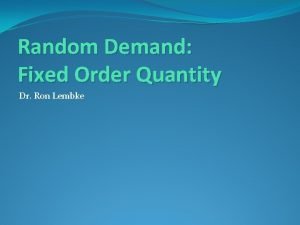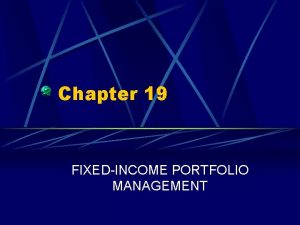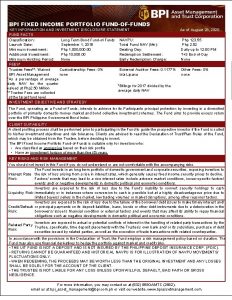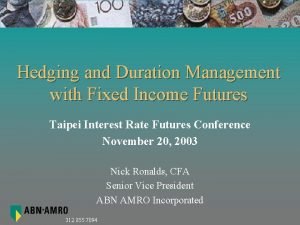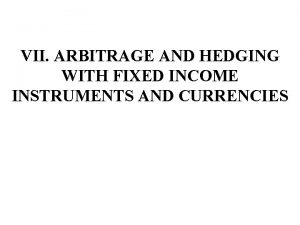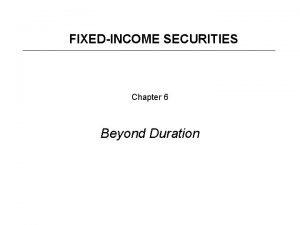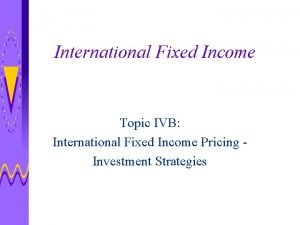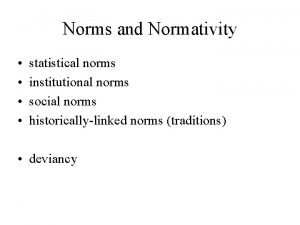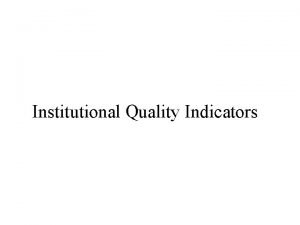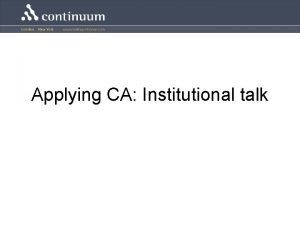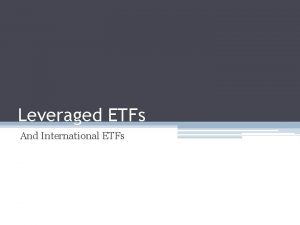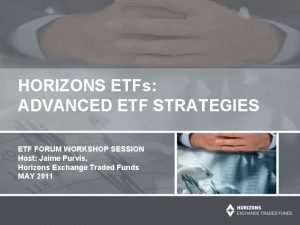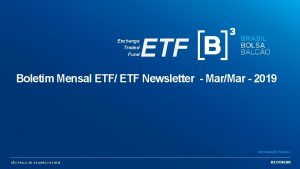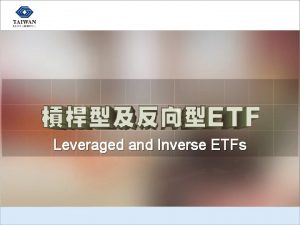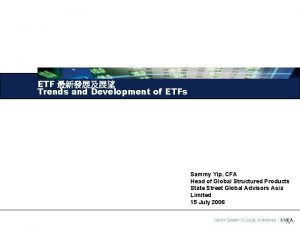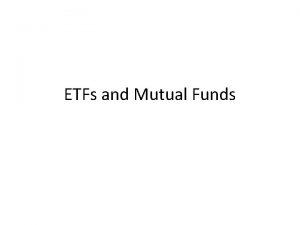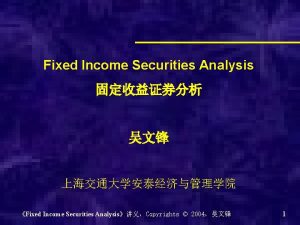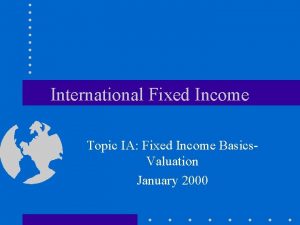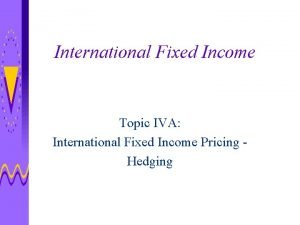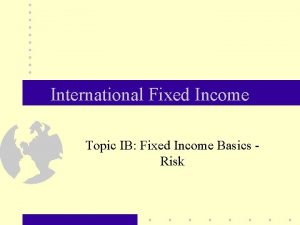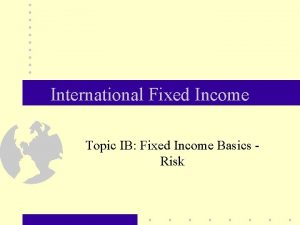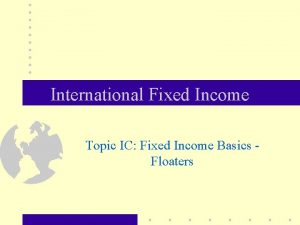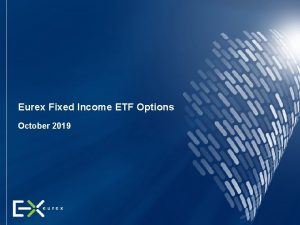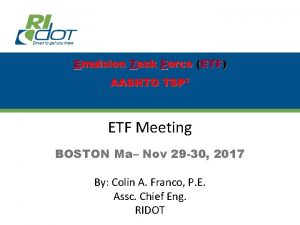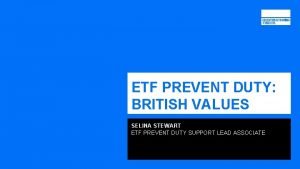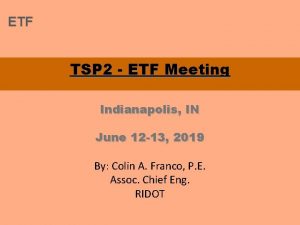Fixed Income ETFs SPDR ETF Institutional Fixed Income































- Slides: 31

Fixed Income ETFs SPDR ETF Institutional Fixed Income Group (FIG) Bill Ahmuty Marcel Benjamin Paul Cappelli Alex Swayne Q 1 2016 FOR INVESTMENT PROFESSIONAL USE ONLY. Not for use with the public. IBG-18055

Table of Contents 1. 2. 3. 4. 5. Who Are We? Why Clients Use ETFs Fixed Income ETF Market Profile ETF Mechanics SPDR Fixed Income ETFs Appendices Appendix A: Bloomberg Fixed Income ETF Analytics Appendix B: ETF Liquidity During High Yield Sell-Off (June 2013) Appendix C: ETF versus Basket Liquidity (June 2013) Appendix D: Important Risk Information Appendix E: Biographies IBG-18055 2

Who Are We? IBG-18055 3

Who Are We? The SSGA SPDR Exchange Traded Funds (ETF) Institutional Fixed Income ETF Group (FIG) is positioned at the center of the fixed income ETF market. It serves as a resource for buy-side clients, the Fixed Income AP community, and SSGA FI Portfolio Managers. We offer a blend of knowledge, perspective, and advanced insights through our experience in the global bond markets, Wall Street networks, and ETF trading experience. FIG Team: • 15 years of Institutional ETF trading experience • 15 years of Institutional buy-side fixed income portfolio management & risk analysis • 10 years of Institutional sell-side fixed income sales experience IBG-18055 4

SPDR ETF Fixed Income Group (FIG) Clients Fixed Income Investor SPDR ETF F. I. Group (FIG) Sell Side (AP’s) PM SSGA Fixed Income Portfolio Managers Sales Desk SSGX Sub-Advisory teams Trading Desk Fixed Income Analyst Market Access Sec Contact Lending Information: spdr_etf_fig@ssga. com ID IBG-18055 5

Why Clients Use ETFs IBG-18055 6

The Case for Using ETFs Application Objective ETF Solution Tactical Adjustments Over or underweight certain market segments based on short term outlook ETFs represent virtually every asset class and can offer efficient vehicles for implementing a tactical idea Transitions Maintain market exposure while searching for a new manager Invest the proceeds of a manager liquidation in an ETF which can track the appropriate benchmark until new manager has been selected Cash Equitization Remain fully invested while maintaining liquidity ETFs can be an attractive alternative solution to futures due to their transparency, lack of documentation and roll slippage Rebalancing Increase the speed and efficiency of rebalancing across the asset allocation ETFs can make rebalancing more efficient due to their intraday liquidity than moving assets from illiquid managers Asset Class Exposure Establish exposure to a difficult to reach market segment There a variety of ETFs which can provide exposure to difficult to reach asset classes Liquidity Management Increase liquidity in overall asset allocation without changing allocation Use ETFs for a given percentage of each asset class to help provide a liquidity buffer across the asset allocation Portfolio Completion Fill any asset allocation holes without engaging a new investment manager Use an ETF to help gain exposure to an asset class that is underrepresented in the asset allocation Fixed Income Duration and Credit Adjustments Tweak duration and credit exposure to meet specified targets Fixed Income ETFs can provide an efficient means to adjust duration and credit exposure Small Institutional Plans Implement desired asset allocation regardless of plan size Aim to implement an asset allocation efficiently using ETFs. Advantages include no minimum fees and simplified rebalancing Source: Common Institutional ETF Uses — SPDR® Institutional ETF Team as of August 24, 2015. There can be no assurance that a liquid market will be maintained for ETF shares. IBG-18055 7

ETF versus CDX versus Swaps versus Futures Fixed Income ETFs CDX Total Return Swap Futures Product Basics Portfolio of cash bonds in ETF wrapper designed to replicate a cash bond index Basket of the most liquid single name CDS (100 for HY; 125 for IG) Economic Total Return of a specified bond index Standardized contracts on various underlying assets Structure Mainly 40 Act funds Derivative Listed Derivative Interest Rate Risk YES NO YES Cash Flows (long/short) Receives/Pay dividend payments and pay/receive expense ratio, earn lending fee/pay borrow cost Receive/pay quarterly premiums, pay/receive an upfront Pay/receive Par-default on any single name defaults Pay/receive quarterly financing, receive/pay total return Settled each day in the form of variation margin due to change in mark to market Transaction Costs Bid/Ask Spreads, commissions, expense ratio, borrow costs Bid ask spread/roll costs Long exposure pays funding costs, bid/ask spreads Exchange, Clearinghouse, NFA & FCM Fees, roll costs Liquidity Primary (Create/Redeem process) and secondary market liquidity Highly Liquid OTC; dealer market Depending on underlying asset class Very liquid to moderate/low liquidity range Expiration/Maturity Perpetual 5 Year Tenors, new series every 6 months Set at initiation, customized Quarterly or Monthly Rebalance/Roll Typically monthly rebalance A new series of an index is created every 6 months Typically short maturities with no roll Quarterly or Monthly Counterparty Risk Exchange traded Swap Counterparty/Central Counter Parties Swap Counterparty Clearinghouse (CPP) Documentation No documentation required FIA ISDA Give Up Agreement, ISDA FIA ISDA addendum, CDEA to allow for trading cleared products ISDA for Bi-lateral trading Futures Customer Agreement & Addendum (OTC Clearing) Margin Requirements Subject to Reg T Initial Margins vary and daily mark to market Margin set by exchanges based on hedge or speculation FCM has discretion to charge a multiple of exchange requirement Bilateral contracts Margin set by counterparties Source: Bloomberg, Markit, CME, Goldman Sachs, SSGM as of December 31, 2015. There can be no assurance that a liquid market will be maintained for ETF shares. IBG-18055 8

Liquidity Spectrum SMA Mutual Fund ETF What is an ETF? • A basket of securities that tracks the performance of a broad or specific market segment – Like stocks, and unlike mutual funds, shares of ETFs are bought and sold on the exchange throughout the day – In many cases, ETFs may offer investors lower expenses, greater transparency and improved tax efficiency relative to mutual funds that track the same market segments – You can buy ETFs in nearly every possible asset class Liquidity Spectrum SMA MF ETF Description • Privately held portfolio • Exchange listed • Exchange Listed • Intra day pricing Price Transparency • Customized per Investment management agreement (IMA) • No intra day price • End of day NAV • Intra day pricing Liquidity/Accessibility • No intra day trading • Dependent on IMA Guidelines • Primary market • Primary and secondary market Frequent trading of ETFs could significantly increase commissions and other costs such that they may offset any savings from low fees or costs. IBG-18055 9

Changes in the Structure of Primary Dealer Balance Sheets Net Dealer Corporate Holdings by Maturity 2015 Net Dealer Investment Grade Holdings by Maturity $20 000 $250 000 $15 000 $10 000 $150 000 ($mm) $200 000 $5 000 $100 000 $0 $50 000 -$5 000 $0 <=1 Yr • • >1 Yr >10 yrs >13 mths<5 yrs 15 15 /2 3 /1 4 12 10 <= 13 mths /2 0 15 20 8/ 5/ 5 5/ 27 /2 01 5 3/ 18 /2 01 15 20 1/ 7/ 7/ 4/ 2 6/ 001 19 /2 0 6/ 02 4/ 2 5/ 003 19 /2 0 5/ 04 4/ 2 4/ 005 19 /2 0 4/ 06 4/ 2 3/ 007 19 /2 0 3/ 08 4/ 2 2/ 009 17 /2 0 2/ 10 2/ 2 1/ 011 18 /2 0 1/ 12 2/ 20 13 -$10 000 5 yrs <= 10 yrs We feel Investors are justifiably concerned about their ability to sell bonds in the next risk off scenario How can investors offset the loss of liquidity in the cash bond markets? Net exposure turned negative at the 5– 10 y point in Q 4 2015 Barclays reports that directional changes are informative but the quantities are not reliable Source: Federal Reserve Bank of New York as of December 30, 2015; Barclays Research 2015 Net Dealer Investment Grade Holdings by maturity represents: January 2015 and On » Net Positions » Corporate » Investment grade bonds, notes, and debentures. IBG-18055 10

US Exchange Listed ETFs by Asset Class ($mm) US focused fixed income ETF assets climbed to ~$331 Billion, as of December 31, 2015 Source: Bloomberg as of December 31, 2015. IBG-18055 11

Fixed Income ETF Market Profile IBG-18055 12

Fixed Income ETF Market Profile Asset Class US Investment Grade Corporate Bonds US High Yield Corporate Bonds US Convertible Bonds EM USD Bonds US Government Bonds US Municipal Bonds Market Size (MM) ETF AUM as % of Index $7, 037, 700 $75, 781 1. 08% 1, 210, 000 33, 404 202, 000 Average Daily Volume (3 M ADV): Bond Trading (MM) ETF ADV as % of Bonds ADV $16, 737 $732 4. 38% 2. 76 9, 922 1, 617 16. 30 2, 628 1. 30 1, 133 43 3. 76 1, 450, 000 10, 463 0. 72 17, 492 174 0. 99 12, 841, 436 48, 784 0. 38 491, 033 1, 912 0. 39 3, 710, 000 18, 105 0. 49 7, 143 108 1. 51 High Yield ETF Volume based on 3 month Average Daily Volume (3 -M ADV), as of December 21, 2015 for Bloomberg ‘Rating Class Focus’ of ‘High Yield’. Market Size Data Source: Barclays, as of December 22, 2015 and SIFMA (Q 3 2015). ETF AUM source: Bloomberg, as of December 21, 2015; Criteria used includes Geo. Focus = United States; Asset Class = Fixed Income; Does not include Bloomberg classified ETFs with the ‘Strategy’ being ‘Aggregate’. ‘Average Daily Volume (3 M ADV) — Bond Trading’ comes from SIFMA, EMTA and Bloomberg, as of December 21, 2015. EM Bonds Average Daily Volume (3 M ADV) — Bond Trading reflects Q 3 2015. Investment Grade, High Yield, Convertible Bonds, EM Bonds, Treasuries, and Municipal ‘Average Daily Volume (3 M ADV) — Bond Trading’ calculated using 65 business days to reflect 3 months using Bloomberg, as of December 21, 2015. IBG-18055 13

ETF Liquidity Enhancement in US High Yield Credit SSGA offers a full suite of fixed income products that are designed to help provide investors access to precise, transparent and liquid exposures within the below investment grade corporate bond market SPDR® Barclays High Yield Bond ETF (JNK) Asset Type Below investment grade bonds Below investment grade senior secured bank loans Below investment grade bonds Investment grade and below investment grade bonds Maturity Spectrum Full Maturity 0 to 5 Year Maturity Full Maturity Fixed/Floating Rate Fixed rate assets Predominantly floating rate assets Fixed rate assets Total Net Assets $9, 6120 MM $2, 860 MM $783 MM $26 MM $32 MM ETF Bid/Ask Spread 0. 03% 0. 04% 0. 11% 1. 17% 0. 83% Barclays Liquidity Cost Score 1. 785 1. 743 N/A 1. 55 N/A Average Daily Volume (3 M) $470 MM $56 MM $9 MM $0. 103 MM $0. 252 MM SPDR® Blackstone/GSO Senior Loan ETF (SRLN) SPDR® Barclays International High Yield Bond ETF (IJNK) SPDR® Bof. A Merrill Lynch Crossover Corporate Bond ETF (CJNK) SPDR® Barclays Short Term High Yield Bond ETF (SJNK) Total Net Assets Source: Bloomberg, as of January 5, 2016. ETF Bid/Ask Spread Source: NYSE Arca, 90 -day Spread as of December 31, 2015. Barclays Liquidity Cost Score (LCS), as of December 31, 2015. Average Daily Volume (3 M) Source: Bloomberg, as of January 6, 2015. There can be no assurance that a liquid market will be maintained for ETF shares. IBG-18055 14

Overview of High Yield ETF Market • Compared to the US High Yield Mutual Fund Market, US High Yield Market Size versus US High Yield Mutual Fund & ETF AUM High Yield ETFs are a small percentage of the overall $1 600 $1 400 • High Yield ETFs have become a notable trading tool • The secondary market volume is additive to the liquidity profile of the overall High Yield market Thousands US High Yield Cash Market $1 200 $1 000 $800 $600 $400 $200 High Yield Volume versus High Yield ETF Primary Market Activity $14 $0 12. 31. 2009 12. 31. 2010 12. 31. 2011 12. 31. 2012 12. 31. 2013 12. 31. 2014 12. 31. 2015 $12 Billions $10 US Focused High Yield ETFs US Focused High Yield Mutual Funds BAML US High Yield Master II $8 $6 $4 During periods of high volatility, the High Yield ETF primary market activity is only a small percentage of overall High Yield cash bond trading $0 1. 2. 2015 1. 16. 2015 1. 30. 2015 2. 13. 2015 2. 27. 2015 3. 13. 2015 3. 27. 2015 4. 10. 2015 4. 2015 5. 8. 2015 5. 22. 2015 6. 5. 2015 6. 19. 2015 7. 3. 2015 7. 17. 2015 7. 31. 2015 8. 14. 2015 8. 2015 9. 11. 2015 9. 25. 2015 10. 9. 2015 10. 23. 2015 11. 6. 2015 11. 2015 12. 4. 2015 12. 18. 2015 $2 HY $ Volume Secondary $ JNK, HYG, SJNK, SHYG Primary $ JNK, HYG , SJNK, SHYG Graphs on this slides come from Bloomberg as of December 31, 2015. There can be no assurance that a liquid market will be maintained for ETF shares. IBG-18055 15

HY ETF Trading Behavior — Premium & Discount • As the market for HY ETFs has matured, we have seen less volatility of the ETF premium/discount around the NAV, and trading tighter to NAV on average • In 2015, JNK traded at a discount to NAV only 20 days – The largest discount recorded was 68 bps (12/11/2015), and eight of those sessions was less than 5 bps JNK Premium & Discount 2008 Avg: 1. 17% High: 9. 90% Low: -8. 76% 2011 Avg: 0. 29% High: 3. 28% Low: -3. 51% 2015 Avg: 0. 27% High: 0. 95% Low: -0. 68% JNK Premium & Discount (%) 10, 00% 8, 00% 6, 00% 4, 00% 2, 00% 0, 00% -2, 00% -4, 00% -6, 00% -8, 00% -10, 00% P/D 2008 P/D 2011 P/D 2015 Source: Bloomberg as of December 31, 2015. IBG-18055 16

ETF Liquidity During High Yield Sell-Off (December 2015) • JNK traded over $3. 84 B during the week of December 7– 11, including two separate days near $1. 2 B each • JNK saw $1. 467 B of redemptions during the week • The secondary to primary volume ratio also maintained its stability, demonstrating that ETF liquidity continues to be additive to the market High Yield Sell-Off (December 2015) • The fund maintained its close relationship to its NAV, continuing to trade within a narrow band • JNK’s price fell 2. 01% on 12/11, closing at a 68 bps discount to NAV Source: Bloomberg as of December 31, 2015. Past performance is no guarantee of future results. The graph above is for illustrative purposes only. There can be no assurance that a liquid market will be maintained for ETF shares. IBG-18055 17

ETF Mechanics IBG-18055 18

Fixed Income ETFs — Trading Fixed Income ETFs generally trade at a premium to net asset value under normal market conditions as fixed income ETF NAVs are typically priced on the bid side The premium or discount of the ETF market price to the Net Asset Value (NAV) of the underlying basket can be a catalyst for the create/redeem process Factors for FI ETF Pricing • NAV calculation • Creation Process — In Kind or Cash • Costs to transact in underlying market • Borrow cost on ETF • Creation Fees • Investor Sentiment • Underlying market — volatility, headline news, default risk, sensitivity to rate movements As the ETF decreases in value relative to the portfolio, arbitrageurs are incented to buy the ETF, redeem units in the ETF and sell the bonds for a profit As the ETF increases in value relative to the portfolio, arbitrageurs are incented to aggregate bonds, create units in the ETF and sell the ETF for a profit • The premium or discount of the ETF market price to the Net Asset Value (NAV) of the underlying basket can be a catalyst for the create/redeem process IBG-18055 19

SPDR Fixed Income ETFs IBG-18055 20

SPDR Fixed Income ETFs Ticker Fund Name Fund Strategy AUM ($MM) SRLN SPDR® Blackstone/GSO Senior Loan ETF Active ETF $783 TOTL SPDR® Double. Line® Total Return Tactical ETF Active ETF 1, 781 ULST SPDR® SSGA Ultra Short Term Bond ETF Active ETF 14 CJNK SPDR® Bof. A Merrill Lynch Crossover Corporate Bond ETF High Yield $32 IJNK SPDR® Barclays International High Yield Bond ETF High Yield 25 JNK SPDR® Barclays High Yield Bond ETF High Yield 9, 620 SJNK SPDR® Barclays Short Term High Yield Bond ETF High Yield 2, 860 CWB SPDR® Barclays Convertible Securities ETF Hybrids $2, 503 PSK SPDR® Wells Fargo® Preferred Stock ETF Hybrids 348 BWX SPDR® Barclays International Treasury Bond ETF International $1, 418 EBND SPDR® Barclays Emerging Markets Local Bond ETF International 67 EMCD SPDR® Bof. A Merrill Lynch Emerging Markets Corporate Bond ETF International 13 IBND SPDR® Barclays International Corporate Bond ETF International 151 BABS SPDR® Nuveen Barclays Build America Bond ETF Municipal $48 CXA SPDR® Nuveen Barclays California Municipal Bond ETF Municipal 107 HYMB SPDR® Nuveen S&P High Yield Municipal Bond ETF Municipal 410 Source: Bloomberg as of December 31, 2015. IBG-18055 21

SPDR Fixed Income ETFs (continued) Ticker Fund Name Fund Strategy AUM ($MM) INY SPDR® Nuveen Barclays New York Municipal Bond ETF Municipal $28 SHM SPDR® Nuveen Barclays Short Term Municipal Bond ETF Municipal 2, 728 TFI SPDR® Nuveen Barclays Municipal Bond ETF Municipal 1, 584 CBND SPDR® Barclays Issuer Scored Corporate Bond ETF Smart Beta BNDS SPDR® Barclays Aggregate Bond ETF US Aggregate $1, 083 BIL SPDR® Barclays 1– 3 Month T-Bill ETF US Government $2, 490 BWZ SPDR® Barclays Short Term International Treasury Bond ETF US Government 176 IPE SPDR® Barclays TIPS ETF US Government 624 SIPE SPDR® Barclays 0– 5 Year TIPS ETF US Government 4 SST SPDR® Barclays Short Term Treasury ETF US Government 66 TIPX SPDR® Barclays 1– 10 Year TIPS ETF US Government 19 TLO SPDR® Barclays Long Term Treasury ETF US Government 322 WIP SPDR® DB International Government Inflation-Protected Bond ETF US Government FLRN SPDR® Barclays Investment Grade Floating Rate ETF US Investment Grade Corporates $389 ITE SPDR® Barclays Intermediate Term Treasury ETF US Investment Grade Corporates 646 ITR SPDR® Barclays Intermediate Term Corporate Bond ETF US Investment Grade Corporates 933 LWC SPDR® Barclays Long Term Corporate Bond ETF US Investment Grade Corporates 157 SCPB SPDR® Barclays Short Term Corporate Bond ETF US Investment Grade Corporates 4, 566 MBG SPDR® Barclays Mortgage Backed Bond ETF US Mortgage $168 $28 567 Source: Bloomberg as of December 31, 2015. IBG-18055 22

Appendices IBG-18055 23

Appendix A: Bloomberg Fixed Income ETF Analytics • Bloomberg “YAS” function uses an “Internal Rate of Return (IRR)” methodology for calculating an ETF’s metrics such as Yield to worst (YTW), duration, convexity and spreads in relation to various benchmarks. “PORT” provides risk/scenario and performance analysis of an ETFs underlying portfolio. “YAS” — Yield and Spread Analysis “PORT” — Portfolio and Risk Analytics Source: Bloomberg — The information contained above is for illustrative purposes only. IBG-18055 24

Appendix A: Bloomberg Fixed Income ETF Analytics (continued) • Bloomberg “WETF” function is the Bloomberg Fixed Income ETF Monitor. “XLTP XETFM” function is the Bloomberg Excel Template Library: US ETF Flows. WETF <GO> — Bloomberg Fixed Income ETF Monitor XLTP XETFM <GO> Source: Bloomberg — The information contained above is for illustrative purposes only. IBG-18055 25

Appendix B: ETF Liquidity During High Yield Sell-Off (June 2013) • Sell-offs occurred in JNK in June 2013 with spikes in volume and volatility • Shares outstanding decreased by 13% ETF price versus ETF NAV JNK NAV Primary and Secondary Market Activity Primary Market Activity ($mm) Secondary Market Activity Volatility — VIX and MOVE Index spike higher MOVE (%) VIX Source: Bloomberg, as of July 1, 2013. Past performance is no guarantee of future results. The information contained above is for illustrative purposes only. There can be no assurance that a liquid market will be maintained for ETF shares. IBG-18055 26

Appendix C: ETF versus Basket Liquidity (June 2013) • On specific trading days throughout the June 2013 selloff, nearly 1/3 of the JNK underlying basket did not trade • JNK continued to act as a means of price discovery in an otherwise inactive market % ETF discount to NAV (%) Number of bonds ETF discount to NAV VIX # of bonds in underlying basket with no trading activity Base line Number of bonds in underlying basket with no trading activity Source: Bloomberg, as of July 1, 2013. Past performance is no guarantee of future results. The information contained above is for illustrative purposes only. There can be no assurance that a liquid market will be maintained for ETF shares. IBG-18055 27

Appendix D: Important Risk Information FOR INVESTMENT PROFESSIONAL USE ONLY. Not for use with the public. The views expressed in this material are the views of SPDR ETF Institutional Fixed Income Group (FIG) through the period ended 1/26/2016 and are subject to change based on market and other conditions. This document contains certain statements that may be deemed forward-looking statements. Please note that any such statements are not guarantees of any future performance and actual results or developments may differ materially from those projected. ETFs trade like stocks, are subject to investment risk, fluctuate in market value and may trade at prices above or below the ETFs net asset value. Brokerage commissions and ETF expenses will reduce returns. In general, ETFs can be expected to move up or down in value with the value of the applicable index. Although ETF shares may be bought and sold on the exchange through any brokerage account, ETF shares are not individually redeemable from the Fund. Investors may acquire ETFs and tender them for redemption through the Fund in Creation Unit Aggregations only. Please see the prospectus for more details. These Funds invest by sampling the Index, holding a range of securities that, in the aggregate, approximates the full Index in terms of key risk factors and other characteristics which may cause the fund to experience tracking errors relative to performance of the Index These investments may have difficulty in liquidating an investment position without taking a significant discount from current market value, which can be a significant problem with certain lightly traded securities. There can be no assurance that a liquid market will be maintained for ETF shares. Investing involves risk including the risk of loss of principal. Generally, among asset classes, stocks are more volatile than bonds or short-term instruments. Government bonds and corporate bonds generally have more moderate short-term price fluctuations than stocks, but provide lower potential long-term returns. US Treasury Bills maintain a stable value if held to maturity, but returns are generally only slightly above the inflation rate. Bonds generally present less short-term risk and volatility than stocks, but contain interest rate risk (as interest rates raise, bond prices usually fall); issuer default risk; issuer credit risk; liquidity risk; and inflation risk. These effects are usually pronounced for longer-term securities. Any fixed income security sold or redeemed prior to maturity may be subject to a substantial gain or loss. The municipal market is volatile and can be significantly affected by adverse tax, legislative or political changes and the financial condition of the issuers of municipal securities. Interest rate increases can cause the price of a debt security to decrease. A portion of the dividends you receive may be subject to federal, state, or local income tax or may be subject to the federal alternative minimum tax. Investing in high yield fixed income securities, otherwise known as junk bonds, is considered speculative and involves greater risk of loss of principal and interest than investing in investment grade fixed income securities. These Lower-quality debt securities involve greater risk of default or price changes due to potential changes in the credit quality of the issuer. International Government bonds and corporate bonds generally have more moderate short-term price fluctuations than stocks, but provide lower potential long-term returns. IBG-18055 28

Appendix D: Important Risk Information (continued) Issuers of convertible securities tend to be subordinate to other debt securities issues by the same issuer, may not be as financially strong as those issuing securities with higher credit ratings, and may be more vulnerable to changes in the economy. Other risks associated with convertible bond investments include: Call risk which is the risk that bond issuers may repay securities with higher coupon or interest rates before the security’s maturity date; liquidity risk which is the risk that certain types of investments may not be possible to sell the investment at any particular time or at an acceptable price; and investments in derivatives, which can be more sensitive to sudden fluctuations in interest rates or market prices, potential illiquidity of the markets, as well as potential loss of principal. Foreign investments involve greater risks than US investments, including political and economic risks and the risk of currency fluctuations, all of which may be magnified in emerging markets. Increase in real interest rates can cause the price of inflation-protected debt securities to decrease. Interest payments on inflation-protected debt securities can be unpredictable. Investments in asset backed and mortgage backed securities are subject to prepayment risk which can limit the potential for gain during a declining interest rate environment and increases the potential for loss in a rising interest rate environment. Treasury bills are insured and guaranteed by the US government. US Treasury Bills maintain a stable value if held to maturity, but returns are generally only slightly above the inflation rate. Passively managed funds invest by sampling the index, holding a range of securities that, in the aggregate, approximates the full Index in terms of key risk factors and other characteristics. This may cause the fund to experience tracking errors relative to performance of the index. Actively managed ETFs do not seek to replicate the performance of a specified index. The Fund is actively managed and may underperform its benchmarks. An investment in the fund is not appropriate for all investors and is not intended to be a complete investment program. Investing in the fund involves risks, including the risk that investors may receive little or no return on the investment or that investors may lose part or even all of the investment. Investments in Senior Loans are subject to credit risk and general investment risk. Credit risk refers to the possibility that the borrower of a Senior Loan will be unable and/or unwilling to make timely interest payments and/or repay the principal on its obligation. Default in the payment of interest or principal on a Senior Loan will result in a reduction in the value of the Senior Loan and consequently a reduction in the value of the Portfolio's investments and a potential decrease in the net asset value ("NAV") of the Portfolio. Non-diversified funds that focus on a relatively small number of securities tend to be more volatile than diversified funds and the market as a whole. Double. Line® is a registered trademark of Double. Line Capital LP. Barclays is a trademark of Barclays, Inc. and has been licensed for use in connection with the listing and trading of the SPDR Barclays ETFs are not sponsored by, endorsed, sold or promoted by Barclays, Inc. and Barclays makes no representation regarding the advisability of investing in them. IBG-18055 29

Appendix D: Important Risk Information (continued) SPDR is a registered trademark of Standard & Poor Financial Services LLC (S&P) and has been licensed for use by State Street Corporation. No financial product offered by State Street Corporation or its affiliates is sponsored, endorsed, sold or promoted by S&P or its Affiliates, and S&P and its affiliates make no representation, warranty or condition regarding the advisability of buying, selling or holding units/shares in such products. Further limitations and important information that could affect investors' rights are described in the prospectus for the applicable product. Distributor: State Street Global Markets, LLC is the distributor for all registered products on behalf of the advisor. SSGA Funds Management has retained GSO Capital Partners, Nuveen Asset Management & Double. Line Capital LP as the sub-advisor. Distributor: State Street Global Markets, LLC, member FINRA, SIPC, a wholly owned subsidiary of State Street Corporation. References to State Street may include State Street Corporation and its affiliates. Certain State Street affiliates provide services and receive fees from the SPDR ETFs. Before investing, consider the funds’ investment objectives, risks, charges and expenses. To obtain a prospectus or summary prospectus which contains this and other information, call 1 -866 -787 -2257 or visit www. spdrs. com. Read it carefully. Not FDIC Insured –No Bank Guarantee – May Lose Value © 2016 State Street Corporation — All Rights Reserved Tracking Code: IBG-18055 Expiration date: 4/20/2016 IBG-18055 30

Appendix E: Biographies Bill Ahmuty Marcel Benjamin Head of SSGA SPDR Fixed Income Group (FIG) Fixed Income Markets/ETF Analyst Bill joined SPDR' ETF Institutional Sales and Capital Markets Team in 2014. Focused on fixed income ETFs, he is responsible for increasing connectivity with SSGA’s broker-dealer partners in the fixed income space and for direct institutional sales coverage to credit funds. SPDR ETF Fixed Income Group (FIG) Bill has over 12 years of ETF trading experience and nearly 20 years of market experience. Prior to SSGA, Bill managed the institutional ETF trading desk at Societe Generale. He has also worked for Newedge managing the ETF sales and trading desk with a focus on commodity arbitrage and Morgan Stanley where he had a 14 year tenure which including working on the CME and CBOE and head trader on the institutional ETF desk. Bill has an undergraduate degree from the University of Notre Dame and earned a Masters of Business Administration from the University of Chicago. Bill has Series 7, 63, 55 and 24. Marcel is a vice president in the SPDR ETF Fixed Income Group, supporting the sales, marketing, and distribution of the firm's bond ETFs Prior to joining SSGA, Marcel was an investment strategist at Swiss Re, helping invest the insurer's balance sheet in dollar and sterling fixed income securities. Prior to that, he was a portfolio manager and trader at Guggenheim Partners Asset Management. Marcel began his career in fixed income portfolio risk management and advisory at Black. Rock. Marcel holds a BA and a BS from the University of Pennsylvania and an MBA from Columbia Business School. He is a CFA charterholder and holds the FINRA Series 7 and 63 licenses. Paul Cappelli Alex Swayne Fixed Income Markets/ETF Sales SPDR ETF Fixed Income Group (FIG) Paul is a vice president in the SPDR ETF Fixed Income Group (FIG) focusing on institutional use of the firm's bond ETFs Alex is a principal in the SPDR ETF Fixed Income Group (FIG), supporting the sales, marketing, and distribution of the firm's bond ETFs Prior to joining SSGA, Paul had 10 years of credit sell side experience, he was most recently at Oppenheimer Inc. focusing on High Yield and distressed sales to institutional clients. Prior to that, he was a credit salesman at Sterne Agee and Citigroup Global Markets. Paul began his career as a foreign exchange analyst at HSBC Bank, NA. Prior to joining the SPDR ETF Fixed Income Group (FIG), he worked on the internal sales desk within the Registered Investment Advisor channel for 3 years. Prior to that, he began his career at State Street in the two-year Professional Development Program where he gained a broad perspective and skill set. Paul holds a BA from the University of Notre Dame and holds the FINRA Series 7 and 63 licenses. Alex holds a BA from Stonehill College and holds the FINRA Series 7 and 63 licenses. IBG-18055 31
 Fixed order quantity
Fixed order quantity What are the schedules of reinforcement
What are the schedules of reinforcement Advantages of pld
Advantages of pld Fixed variable ratio interval
Fixed variable ratio interval Variable interval
Variable interval The invoice price of a bond is the ______.
The invoice price of a bond is the ______. Passive bond portfolio management strategies
Passive bond portfolio management strategies Pricing fixed income securities
Pricing fixed income securities Bpi fixed income portfolio fund-of-funds
Bpi fixed income portfolio fund-of-funds Fixed income futures
Fixed income futures Fixed income hedging
Fixed income hedging Fixed income valuation methods
Fixed income valuation methods Fixed income accounting
Fixed income accounting International fixed income
International fixed income Deferred tax asset
Deferred tax asset Disposable personal income formula
Disposable personal income formula Total income
Total income Chapter 16 accounting for income taxes
Chapter 16 accounting for income taxes Product vs institutional promotion
Product vs institutional promotion Institutional medicaid
Institutional medicaid Institutional norms
Institutional norms Upspace institutional repository
Upspace institutional repository Institutional building
Institutional building Institutional quality index
Institutional quality index Institutional voids
Institutional voids Institutional affiliation meaning
Institutional affiliation meaning Ucf office of institutional equity
Ucf office of institutional equity Institutional development program
Institutional development program Institutional talk
Institutional talk Sonia liou
Sonia liou New directions for institutional research
New directions for institutional research Institutional framework for business
Institutional framework for business
